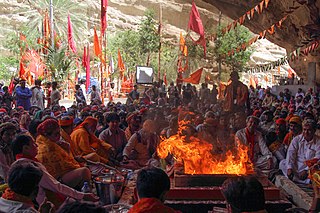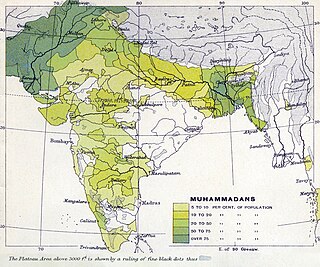
Hindus are people who religiously adhere to Hinduism. Historically, the term has also been used as a geographical, cultural, and later religious identifier for people living in the Indian subcontinent.

Islam is India's second-largest religion, with 14.2% of the country's population, or approximately 172.2 million people, identifying as adherents of Islam in a 2011 census. India also has the third-largest number of Muslims in the world. The majority of India's Muslims are Sunni, with Shia making up around 15% of the Muslim population.

Hinduism is the second largest religious affiliation in People's Republic of Bangladesh, as according to the 2022 Census of Bangladesh, approximately 13.1 million people responded that they were Hindus, constituting 7.95% out of the total population of 165.15 million people. In terms of population, Bangladesh is the third-largest Hindu populated country of the world, just after the neighboring republics of India and Nepal in the subcontinent. Hinduism is the second-largest religion in 61 out of 64 districts of Bangladesh, but there is no Hindu majority district in Bangladesh.

Hinduism is the second largest religious affiliation in Pakistan after Islam. While Hinduism was one of the dominant faiths in the region a few centuries back, today Hindus account for only 2.14% of Pakistan's population or about 4.4 million people according to the 2017 Pakistani census. The Umerkot district has the highest percentage of Hindu residents in the country at 52.2%, while Tharparkar district has the most Hindus in absolute numbers at 714,698.
India since its independence in 1947 has been a secular state. The secular values were enshrined in the constitution of India. India's first prime minister Jawaharlal Nehru is credited with the formation of the secular republic in the modern history of the country. With the Forty-second Amendment of the Constitution of India enacted in 1976, the Preamble to the Constitution asserted that India is a secular nation. However, the Supreme Court of India in the 1994 case S. R. Bommai v. Union of India established the fact that India was secular since the formation of the republic. The judgement established that there is separation of state and religion. It stated "In matters of State, religion has no place. Any State government which pursues nonsecular on policies or nonsecular course of action acts contrary to the constitutional mandate and renders itself amenable to action under Article 356". Furthermore, constitutionally, state-owned educational institutions are prohibited from imparting religious instructions, and Article 27 of the constitution prohibits using tax-payers money for the promotion of any religion.

The two-nation theory was an ideology of religious nationalism that advocated Muslim Indian nationhood, with separate homelands for Indian Muslims and Indian Hindus within a decolonised British India, which ultimately led to the Partition of India in 1947. Its various descriptions of religious differences were the main factor in Muslim separatist thought in the Indian subcontinent, asserting that Indian Muslims and Indian Hindus are two separate nations, each with their own customs, traditions, art, architecture, literature, interests, and ways of life.

From a historical perspective, Professor Ishtiaq Ahmed of the University of Stockholm and Professor Shamsul Islam of the University of Delhi classified the Muslims of the subcontinent into two categories during the era of the Indian independence movement: Indian nationalist Muslims and Indian Muslim nationalists. The All India Azad Muslim Conference represented Indian nationalist Muslims, while the All-India Muslim League represented the Indian Muslim nationalists. One such popular debate was the Madani–Iqbal debate.

East Bengal was a non-contiguous province of the Dominion of Pakistan. Geographically eastern part of the Bengal region, East Bengal existed from 1947 until 1955, when it was renamed East Pakistan. Today, the area is an independent country, Bangladesh. With its coastline on the Bay of Bengal, it bordered India and Burma. It was located close to, but did not share a border with, Nepal, Tibet, the Kingdom of Bhutan and the Kingdom of Sikkim. Its capital was Dacca, now known as Dhaka.

The official religion of Pakistan is Islam, as enshrined by Article 2 of the Constitution, and is practised by approximately 96.47% of the country's population. The remaining 3.53% practice Hinduism, Christianity, Ahmadiyya Islam, Sikhism and other religions.

Punjabi Hindus are adherents of Hinduism who identify ethnically, linguistically, culturally, and genealogically as Punjabis and are natives of the Punjab region of the Indian subcontinent. Punjabi Hindus are the second-largest religious group of the Punjabi community, after the Punjabi Muslims. While Punjabi Hindus mostly inhabit the Indian state of Punjab, as well as Haryana, Himachal Pradesh, Delhi, and Chandigarh today, many have ancestry across the greater Punjab region, which was partitioned between India and Pakistan in 1947.

Since its independence in 1947, India has accepted various groups of refugees from neighbouring countries, including partition refugees from former British Indian territories that now constitute Pakistan and Bangladesh, Tibetan refugees that arrived in 1959, Chakma refugees from present day Bangladesh in early 1960s, other Bangladeshi refugees in 1965 and 1971, Sri Lankan Tamil refugees from the 1980s and most recently Rohingya refugees from Myanmar. In 1992, India was seen to be hosting 400,000 refugees from eight countries. According to records with the Union Ministry of Home Affairs, as on January 1,2021, there were 58,843 Sri Lankan refugees staying in 108 refugee camps in Tamil Nadu and 54 in Odisha and 72,312 Tibetan refugees have been living in India.

Indian Sikhs number approximately 21 million people and account for 1.7% of India's population as of 2011, forming the country's fourth-largest religious group. The majority of the nation's Sikhs live in the northern state of Punjab, which is the only Sikh-majority administrative division in the world.
United Bengal was a proposal to transform Bengal Province into an undivided, sovereign state at the time of the Partition of India in 1947. It sought to prevent the division of Bengal on religious grounds. The proposed state was to be called the Free State of Bengal. A confessionalist political system was mooted. The proposal was not put up for a vote. The British government proceeded to partition Bengal in accordance with the Mountbatten Plan and Radcliffe Line.

Religion in India is characterised by a diversity of religious beliefs and practices. Throughout India's history, religion has been an important part of the country's culture and the Indian subcontinent is the birthplace of four of the world's major religions, namely, Buddhism, Hinduism, Jainism, and Sikhism, which are collectively known as native Indian religions or Dharmic religions and represent approx. 83% of the total population of India.
The United Nations categorizes Bangladesh as a moderate democratic Muslim country. Sunni Islam is the largest and most dominant religion practiced in the country. In the Constitution of Bangladesh, Islam is referred to twice in the introduction and Part I of the constitution. The document begins with the Islamic phrase Bismillahir Rahmanir Raheem which in English is translated as "In the name of Allah, the Beneficent, the Merciful" and article (2A) declares that:"Islam is the state religion of the republic".

Bengali Hindus are an ethnoreligious population who make up the majority in the Indian states of West Bengal, Tripura, Andaman and Nicobar Islands, Jharkhand, and Assam's Barak Valley region. In Bangladesh, they form the largest minority. They are adherents of Hinduism and are native to the Bengal region in the eastern part of the Indian subcontinent. Comprising about one-third of the global Bengali population, they are the second-largest ethnic group among Hindus after Hindustani Hindus. Bengali Hindus speak Bengali, which belongs to the Indo-Aryan language family and adhere to Shaktism or Vaishnavism of their native religion Hinduism with some regional deities. There are significant numbers of Bengali-speaking Hindus in different Indian states. According to the census in 1881, 12.81 per cent of Bengali Hindus belonged to the three upper castes while the rest belonged to the Shudra and Dalit castes.

Indian reunification refers to the potential reunification of India with Pakistan and Bangladesh, which were partitioned from British India in 1947.
The Citizenship (Amendment) Act, 2019 (CAA) was passed by the Parliament of India on 11 December 2019. It amended the Citizenship Act, 1955 by providing an accelerated pathway to Indian citizenship for persecuted religious minorities from Afghanistan, Bangladesh and Pakistan who arrived in India by 2014. The eligible minorities were stated as Hindus, Sikhs, Buddhists, Jains, Parsis or Christians. The law does not grant such eligibility to Muslims from these countries. The act was the first time that religion had been overtly used as a criterion for citizenship under Indian law, and it attracted global criticism.

Hinduism is the largest religion in South Asia with about 1.2 billion Hindus, forming just under two-thirds of South Asia's population. South Asia has the largest population of Hindus in the world, with about 99% of all global Hindus being from South Asia. Hinduism is the dominant religion in India and Nepal and is the second-largest religion in Bangladesh, Pakistan, Sri Lanka, and Bhutan.

Hinduism is the dominant religion practised in the state of Assam. According to some scholars, it is home to some of the most complex and poorly understood traditions in Hinduism. People follow traditions belonging to Shaivism, Shaktism, Tantra, and an indigenous form of Vaishnavism called Ekasarana Dharma; taken together the practitioners constitute around 61% of the state population as per the 2011 Census. Hindus form a majority in 17 out of the 29 districts of Assam. By region, there is a significant diversity among the ethnic groups that profess the Hindu faith, traditions, and customs. As per as 2011 Census, In Brahmaputra valley of Assam, Hindus constitute 62% of the population, the majority being ethnic Assamese. In the autonomous Bodoland region of Assam, Hindus constitute 71.3% of the region's population, most being of the Bodo tribe. In the Barak valley region of southern Assam, Hindus constitute 50% of the region's population, most being ethnic Bengalis. The Hill Tribes of Assam, particularly the Karbi people of Karbi Anglong and Dimasa people of Dima Hasao, are mainly Animism.

















